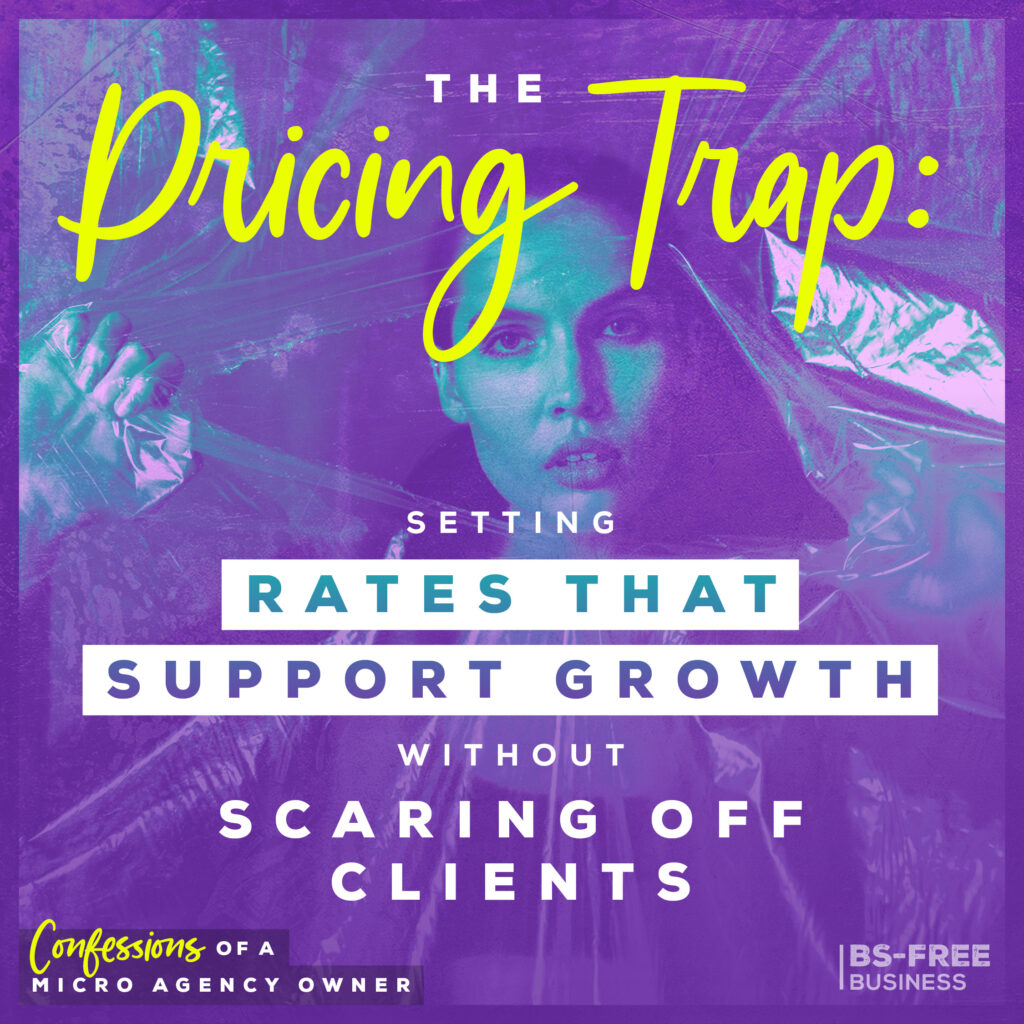
Search the site:
The Pricing Trap: Setting Rates That Support Growth Without Scaring Off Clients
Too many micro agency owners are drowning in tasks they should delegate because their prices don’t quite cut it. The result? Resentment, frustration, and a whole lot of “OMG, why am I doing this again?”
Are your rates working for you or against you? In this episode, we’re diving into the pricing trap that keeps micro agency owners stuck and how to finally escape it.
Listen to this episode now:
Today, we’re diving into one of the most common struggles for micro agency owners: pricing.
Pricing is tricky when you’re a solo show, but it gets far more complex when you factor in your employee or contractor costs and your agency’s other expenses.
You can’t charge for services the same way you would as a scrappy freelancer without eroding your profit. On the other hand, you don’t want to find yourself in a position where your rates are so high that your potential clients aren’t willing to pay them.
That’s why I’m talking about The Pricing Trap, which too many micro agency owners find themselves stuck in. They don’t price high enough to support their growth because they fear scaring off clients.
This brings me to today’s confession: too many times (especially in the early days of my agency), I held back from delegating work because my pricing wasn’t high enough. I knew exactly what it would cost me to hand it off to one of our contract writers, so I’d write it myself to “save” money.
In my pricing, I didn’t always account for the hard costs of having someone else do the work, which added a layer of overhead to their projects. Honestly, that was no one’s fault but my own, and I was hesitant to raise prices as I didn’t want potential clients to say no.
The situation I just shared is at the heart of the pricing trap.
The Pricing Trap Explained
Some of you are nodding along as you know this exact situation, and the rest think your prices are high enough, so you’re good.
No matter which category you fall into, you may still be stuck in the pricing trap.
The pricing trap isn’t just about setting rates that feel comfortable or competitive; it’s about setting rates that genuinely work for everyone involved—you, your team, and your clients. It’s not just about covering your costs and leaving a little bit of profit on the table; it’s about ensuring that your pricing structure aligns with the value you’re delivering and the sustainability of your business.Your actual pricing numbers matter less than the fact that those numbers need to align to support all the elements of your business.
Let’s break it down.
You
Your pricing needs to reflect the value of your time and expertise. You didn’t start your micro agency to work yourself into exhaustion for just enough to get by. Your rates need to account for your skill level, the quality of work you deliver, and the unique value you bring to the table. You’re setting yourself up for frustration if you’re not charging enough.
Your Team
As a micro agency owner, your employees or contractors contribute to your projects. Your pricing must be high enough to have the right resources and pay them well. If you have employees, you need to be able to invest in their growth and ensure that they’re motivated and engaged. If you’re squeezing your margins too tight, it will reflect the quality of your team’s work and overall satisfaction.
Your Clients
While it might seem counterintuitive, charging more can benefit your clients. Why? When you charge enough to support you and your team, you can deliver a higher level of service. You have the resources to go above and beyond, invest in tools and processes that improve the client experience, and dedicate the time and attention needed to deliver outstanding results.
When your pricing doesn’t align with these three pillars—your needs, your team’s needs, and your clients’ needs—you fall into the pricing trap.
You might think your prices are high enough because they cover your costs and leave a bit of profit, but if they do not truly support your business’s full scope, you’re still at risk.
Imagine this: you’ve set your rates, and on paper, they look good. You’re covering your costs, paying your team, and making a profit. But what happens when a client project takes longer than expected? What happens when you need to upgrade your software or invest in additional training for your team?
If your pricing isn’t built to accommodate these realities, you’ll constantly be playing catch-up, and that’s not sustainable.
The real trap is thinking that pricing is just about making the numbers work now. Sustainable pricing ensures those numbers work for you, your team, and your clients in the long run. It’s about building enough buffer to handle the unexpected, investing in growth, and ensuring everyone involved in your business thrives.So, as you evaluate your pricing strategy, don’t just ask, “Is this enough to get by?” Ask, “Is this enough to support me, my team, and my clients in the way I want?”
If the answer is no, then it’s time to adjust. Because pricing isn’t just a number—it’s a foundation. And if that foundation isn’t solid, everything else is at risk of crumbling.
Setting Rates That Support Your Micro Agency’s Growth
So, how do you set rates that support growth without scaring off clients?
This is the proverbial question for every service business owner, especially micro agency owners, and there’s no one-size-fits-all answer.
Here are a few options to consider.
I’m sure you know your numbers, but you need to look beyond the basics to consider costs, desired profit margins, and business goals.
Accounting for Direct and Indirect Costs
You have direct costs like software, tools, and labor, but you also need to account for indirect ones such as taxes, processing fees, and other less obvious ones. Your pricing must account for every expense associated with delivering your services. If you’re not covering these costs, you’re subsidizing your clients.
Desired Profit Margin
Your profit margin is what’s left after all your costs are covered. The money allows you to reinvest in your business, save for future expenses, or pay yourself a well-deserved salary. Many micro agency owners make the mistake of setting their rates just high enough to cover costs, but this leaves no room for growth or unexpected expenses. Decide on a profit margin that aligns with your growth goals and build that into your rates.
Adding a Growth Margin
Finally, you must align your pricing strategies with your goals to grow. Your rates should be high enough to support the additional resources you’ll need, like team members or upgraded tools in the future.
Think of this as a growth margin where you factor in the investments you’ll need to grow without scrambling for new revenue sources.
Value-Based Pricing
This is a game-changer for many micro agency owners. Instead of pricing your services based on the hours you spend, value-based pricing focuses on the value your work delivers to the client.
Think about it this way: If your service helps clients increase their revenue by $100,000 a year, charging them $10,000 is still a bargain, even if the work only takes a few hours.
Value-based pricing requires you to shift your mindset. It’s not about trading time for money but trading value for money. To implement this, you need to understand the tangible and intangible benefits your services provide. Maybe you’re saving your clients time, reducing stress, or helping them reach new markets.
Whatever the value is, make sure your pricing reflects it.
Capacity-Driven Pricing
Your pricing strategy should be closely tied to your available capacity and the workload you can sustainably manage.
For example, let’s say your team can deliver 100 hours of billable work per week, and you know that to meet your goals, your micro agency needs to generate $10k per week. Capacity-driven pricing immediately tells you that you need a baseline rate of $100 per hour.
If you’re constantly “booked out,” that’s a sign that you need to raise your rates and implement capacity-driven pricing. With limited capacity, your prices must be higher to maximize your resources.
I like this approach as it’s not uncommon for micro agency owners to push past their team’s capacity limits to keep revenue flowing. If you’re focused on the available capacity and know the pricing serves everyone involved, you’ll be better equipped to say no to clients you don’t have room for.
These approaches enable you to set rates that work for you, your team and your clients.
Communicating Your Value to Clients
Now, I want to discuss the “not scaring off” clients part of the pricing equation.
This is a quick reminder that your micro agency’s services aren’t for everyone. You shouldn’t be getting a yes from every potential client. (If your close rate exceeds 80%, you need to raise your prices.)
Thinking about clients who’ve said no to working with you and your team in the last 12 to 24 months, what do they have in common?
We often conclude that it’s the price when it’s much more complicated than that. Even if your potential client claims it’s the price, there’s always more to it.
That’s why communicating your value to potential clients can’t be underestimated; if they don’t understand what you’re offering, they’re not willing to pay your rates.
I’m aware that sounds simple, but it’s anything but. Here are some ways to better communicate your value to clients beyond the basics:
- Build Your Cachet: Your brand cachet is all about perception. Position you and your team as experts by consistently delivering high-quality work and showcasing your successes through testimonials and case studies. Don’t just sell services; sell the unique experience and results only your micro agency can provide. By establishing a reputation for excellence, you elevate your brand’s value in clients’ eyes, making them more willing to pay premium rates for your expertise.
- Pro-Level Proposals: Your proposals need to be more than a scope of work and pricing as a micro agency owner. They’re a sales tool that should create an experience for your potential client. Take the time to explain what’s involved and why it costs what it does. This isn’t about justifying your prices but providing the context for your work and why you’re worth it.
- Showcase Results: Create detailed case studies that showcase the outcomes you’ve achieved for clients and the value your services provided in helping them reach their goals. These stories help potential clients envision similar successes and understand the impact your work can have.
- Demonstrate Understanding of Industry Trends: Show clients that you are not just reacting to trends but are ahead of them. Discuss how your approach aligns with or anticipates changes in their industry, positioning you as an essential partner in their growth and success.
Pricing is About So Much More Than Math
Setting your rates is about more than just numbers. It’s about understanding your value beyond the obvious, communicating that value to your clients, and having the confidence to price in a way that works for you, your team and your clients.
Before we wrap up, here’s an actionable tip: Review your current pricing strategy and carefully examine your margins on those services. If you constantly have to jump in on everything or can’t “afford” the support you need to stop wearing all the hats, that’s a sign you need more margin for your team costs.
Bringing awareness to how pricing impacts your business decisions is a step in the right direction.
Remember, pricing is a struggle most micro agency owners face. No matter how long you’ve been offering your services, getting the right balance between the needs of the business, your clients, and your team can be challenging.

I’m Maggie Patterson (she/her), and services businesses are my business.
I have 20+ years of experience with client services, am a consultant for agency owners, creatives, and consultants, and vocal advocate for humane business practices rooted in empathy, respect, and trust.
For Solo Business Owners

Growing a solo service business is tough.
It’s even harder when you’re bombarded with BS advice that steers you away from your values and why you started your business in the first place.
This is the podcast for solo creatives and consultants who want to remain as a team of one and have zero interest in the hustle and grind of typical business teachings.
Subscribe now and never miss an episode.
For Micro Agency Owners
Most podcasts for agency owners obsess over revenue growth as the ultimate success metric.

But here’s the truth: not everyone wants to make millions. Your goal might be to build a sustainable business that lets you have a life and doesn’t run you into the ground.
Join me as I spill my shameless confessions and share everything I’ve learned about building a micro agency that skips the BS of tired and typical agency teachings.
Follow Now on All Major Podcast Platforms








